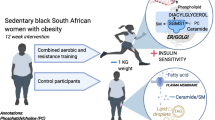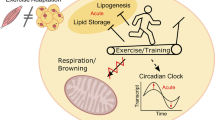Abstract
Aims/hypothesis
Targeted metabolomic and transcriptomic approaches were used to evaluate the relationship between skeletal muscle metabolite signatures, gene expression profiles and clinical outcomes in response to various exercise training interventions. We hypothesised that changes in mitochondrial metabolic intermediates would predict improvements in clinical risk factors, thereby offering novel insights into potential mechanisms.
Methods
Subjects at risk of metabolic disease were randomised to 6 months of inactivity or one of five aerobic and/or resistance training programmes (n = 112). Pre/post-intervention assessments included cardiorespiratory fitness (\( \overset{\cdot }{V}{\mathrm{O}}_{2\mathrm{peak}} \)), serum triacylglycerols (TGs) and insulin sensitivity (SI). In this secondary analysis, muscle biopsy specimens were used for targeted mass spectrometry-based analysis of metabolic intermediates and measurement of mRNA expression of genes involved in metabolism.
Results
Exercise regimens with the largest energy expenditure produced robust increases in muscle concentrations of even-chain acylcarnitines (median 37–488%), which correlated positively with increased expression of genes involved in muscle uptake and oxidation of fatty acids. Along with free carnitine, the aforementioned acylcarnitine metabolites were related to improvements in \( \overset{\cdot }{V}{\mathrm{O}}_{2\mathrm{peak}} \), TGs and SI (R = 0.20–0.31, p < 0.05). Muscle concentrations of the tricarboxylic acid cycle intermediates succinate and succinylcarnitine (R = 0.39 and 0.24, p < 0.05) emerged as the strongest correlates of SI.
Conclusions/interpretation
The metabolic signatures of exercise-trained skeletal muscle reflected reprogramming of mitochondrial function and intermediary metabolism and correlated with changes in cardiometabolic fitness. Succinate metabolism and the succinate dehydrogenase complex emerged as a potential regulatory node that intersects with whole-body insulin sensitivity. This study identifies new avenues for mechanistic research aimed at understanding the health benefits of physical activity.
Trial registration ClinicalTrials.gov NCT00200993 and NCT00275145
Funding This work was supported by the National Heart, Lung, and Blood Institute (National Institutes of Health), National Institute on Aging (National Institutes of Health) and National Institute of Arthritis and Musculoskeletal and Skin Diseases (National Institutes of Health).






Similar content being viewed by others
Abbreviations
- BCAA:
-
Branched-chain amino acid
- CrAT:
-
Carnitine acetyltransferase
- SI :
-
Insulin sensitivity index
- SDH:
-
Succinate dehydrogenase
- STRRIDE:
-
Studies of Targeted Risk Reduction Interventions through Defined Exercise
- TCA:
-
Tricarboxylic acid
- TG:
-
Triacylglycerol
- \( \overset{\cdot }{V}{\mathrm{O}}_{2\mathrm{peak}} \) :
-
Cardiopulmonary fitness as determined by a maximal treadmill test
References
Physical Activity Guidelines Advisory Committee (2008) Physical activity guidelines advisory committee report, 2008. Washington, DC: US Department of Health and Human Services
Duscha BD, Slentz CA, Johnson JL et al (2005) Effects of exercise training amount and intensity on peak oxygen consumption in middle-age men and women at risk for cardiovascular disease. Chest 128:2788–2793
Houmard JA, Tanner CJ, Slentz CA, Duscha BD, McCartney JS, Kraus WE (2004) Effect of the volume and intensity of exercise training on insulin sensitivity. J Appl Physiol 96:101–106
Kraus WE, Houmard JA, Duscha BD et al (2002) Effects of the amount and intensity of exercise on plasma lipoproteins. N Engl J Med 347:1483–1492
Jacobs RA, Lundby C (2013) Mitochondria express enhanced quality as well as quantity in association with aerobic fitness across recreationally active individuals up to elite athletes. J Appl Physiol 114:344–350
Bain JR, Stevens RD, Wenner BR, Ilkayeva O, Muoio DM, Newgard CB (2009) Metabolomics applied to diabetes research: moving from information to knowledge. Diabetes 58:2429–2443
Shah SH, Kraus WE, Newgard CB (2012) Metabolomic profiling for the identification of novel biomarkers and mechanisms related to common cardiovascular diseases: form and function. Circulation 126:1110–1120
Huffman KM, Slentz CA, Bateman LA et al (2011) Exercise-induced changes in metabolic intermediates, hormones, and inflammatory markers associated with improvements in insulin sensitivity. Diabetes Care 34:174–176
Willis LH, Slentz CA, Bateman LA et al (2012) Effects of aerobic and/or resistance training on body mass and fat mass in overweight or obese adults. J Appl Physiol 113:1831–1837
Bergman RN (2007) Orchestration of glucose homeostasis: from a small acorn to the California oak. Diabetes 56:1489–1501
Duscha BD, Kraus WE, Keteyian SJ et al (1999) Capillary density of skeletal muscle: a contributing mechanism for exercise intolerance in class II-III chronic heart failure independent of other peripheral alterations. J Am Coll Cardiol 33:1956–1963
Newgard CB, An J, Bain JR et al (2009) A branched-chain amino acid-related metabolic signature that differentiates obese and lean humans and contributes to insulin resistance. Cell Metab 9:311–326
Haqq AM, Lien LF, Boan J et al (2005) The Study of the Effects of Diet on Metabolism and Nutrition (STEDMAN) weight loss project: rationale and design. Contemp Clin Trials 26:616–625
Tumor Analysis Best Practices Working Group (2004) Expression profiling–best practices for data generation and interpretation in clinical trials. Nat Rev Genet 5:229–237
Seo J, Bakay M, Chen YW, Hilmer S, Shneiderman B, Hoffman EP (2004) Interactively optimizing signal-to-noise ratios in expression profiling: project-specific algorithm selection and detection p-value weighting in Affymetrix microarrays. Bioinformatics 20:2534–2544
Slentz CA, Aiken LB, Houmard JA et al (2005) Inactivity, exercise, and visceral fat. STRRIDE: a randomized, controlled study of exercise intensity and amount. J Appl Physiol 99:1613–1618
Huffman KM, Shah SH, Stevens RD et al (2009) Relationships between circulating metabolic intermediates and insulin action in overweight to obese, inactive men and women. Diabetes Care 32:1678–1683
Huffman KM, Slentz CA, Johnson JL et al (2008) Impact of hormone replacement therapy on exercise training-induced improvements in insulin action in sedentary overweight adults. Metabolism 57:888–895
Boyle KE, Canham JP, Consitt LA et al (2011) A high-fat diet elicits differential responses in genes coordinating oxidative metabolism in skeletal muscle of lean and obese individuals. J Clin Endocrinol Metab 96:775–781
Noland RC, Koves TR, Seiler SE et al (2009) Carnitine insufficiency caused by aging and overnutrition compromises mitochondrial performance and metabolic control. J Biol Chem 284:22840–22852
Koves TR, Li P, An J et al (2005) Peroxisome proliferator-activated receptor-gamma co-activator 1alpha-mediated metabolic remodeling of skeletal myocytes mimics exercise training and reverses lipid-induced mitochondrial inefficiency. J Biol Chem 280:33588–33598
Koves TR, Ussher JR, Noland RC et al (2008) Mitochondrial overload and incomplete fatty acid oxidation contribute to skeletal muscle insulin resistance. Cell Metab 7:45–56
Chao LC, Wroblewski K, Zhang Z et al (2009) Insulin resistance and altered systemic glucose metabolism in mice lacking Nur77. Diabetes 58:2788–2796
Muoio DM, Noland RC, Kovalik JP et al (2012) Muscle-specific deletion of carnitine acetyltransferase compromises glucose tolerance and metabolic flexibility. Cell Metab 15:764–777
Wang TJ, Larson MG, Vasan RS et al (2011) Metabolite profiles and the risk of developing diabetes. Nat Med 17:448–453
Anderson EJ, Lustig ME, Boyle KE et al (2009) Mitochondrial H2O2 emission and cellular redox state link excess fat intake to insulin resistance in both rodents and humans. J Clin Invest 119:573–581
Acknowledgements
We thank the rest of the STRRIDE research team at East Carolina University and Duke University.
Funding
This work was supported by the National Heart, Lung, and Blood Institute (National Institutes of Health) R01HL-57354 (WEK), National Institute on Aging (National Institutes of Health) P30 AGO28716-01 (WEK, KMH), R01AG-028930 and R01DK-089312 (DMM) and National Institute of Arthritis and Musculoskeletal and Skin Diseases (National Institutes of Health) K23AR054904 (KMH).
Duality of interest
The authors declare that there is no duality of interest associated with this manuscript.
Contribution statement
KMH, DMM, and WEK participated in conceptual design, data analysis and data interpretation and drafting and editing of the manuscript. EPH participated in conceptual design, data interpretation and editing of the manuscript. TRK, MJH, HA, NB, LAB, RDS and ORI participated in data collection, data interpretation and editing of the manuscript. All authors approved the final version. KMH is the guarantor of this work.
Author information
Authors and Affiliations
Corresponding author
Electronic supplementary material
Below is the link to the electronic supplementary material.
ESM Fig. 1
(PDF 15 kb)
ESM Table 1
(PDF 160 kb)
Rights and permissions
About this article
Cite this article
Huffman, K.M., Koves, T.R., Hubal, M.J. et al. Metabolite signatures of exercise training in human skeletal muscle relate to mitochondrial remodelling and cardiometabolic fitness. Diabetologia 57, 2282–2295 (2014). https://doi.org/10.1007/s00125-014-3343-4
Received:
Accepted:
Published:
Issue Date:
DOI: https://doi.org/10.1007/s00125-014-3343-4




